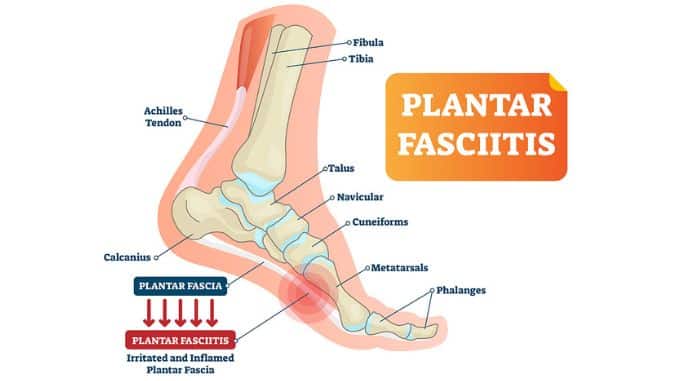Plantar Fasciitis
The plantar fasciitis is an overuse injury involving the plantar fascia. A tough, fibrous band of tissue that supports the longitudinal arch of the foot. Also known as jogger’s heel, tennis heel, or Policeman’s heel. Plantar fasciitis is one of the most common injuries affecting athletes and individuals who are constantly on their feet for a long period of time.
Severe heel pain usually is described as knife-like, especially during the first few steps in the morning. According to the American Academy of Podiatric Sports Medicine, heel pain is the most common presenting symptom of patients who seek treatment from podiatric practitioners. Buchbinder (2004) estimates that each year, 10% of foot injuries associated with running are attributable to plantar fasciitis.
The feet support the weight of the entire body, playing a critical role in stability, locomotion, and propulsion. Therefore any injury or pain involving the feet should be a cause of concern. Plantar fasciitis is a painful and debilitating condition that involves immediate treatment and intensive rehabilitation. Therefore, preventive exercises, early detection, and time management are very important.
Anatomy of the Plantar Fasciitis

The feet perform two functions that require a high degree of stability: weight-bearing and propulsion. Moreover, the foot must be flexible and tensile enough to accommodate uneven surfaces or terrain and absorb shock when walking (Bolgla & Malone, 2004). Evolution enabled humans to walk upright in a locomotive fashion.
This form of motion is energy-saving, and it allows us to use our hands to perform other activities; however, bipedalism can place a great amount of stress on the lower extremities, especially the on feet.
The continuous exposure to stress is clearly evident in the anatomical structure of the foot. Each foot is composed of 28 bones, 33 joints, 19 muscles occurring in 4 layers, and a network of blood vessels, nerves, and soft tissues. The feet are supported by a total of 56 bones, a number that represents 25% of the bones in the human body.
The arch is the most important structure of the feet, as it endures the entire body weight and absorbs a great amount of stress every time the body thrusts the feet with each stride. Therefore, any alteration or injury involving the arches can have a drastic effect on balance and gait.
The foot has three arches: the medial longitudinal arch, the lateral longitudinal arch, and the transverse arch. The medial longitudinal arch, the highest arch, functions as the chief load-bearing structure in the foot (Glasoe, Yack & Saltzman, 1999).
The plantar fascia is a nonelastic, tough band of tissue that runs from the calcaneus, or heel bone, to the heads of the long bones – the bones that form the ball of your foot. The plantar fascia forms the arch of the foot.
It provides stability during stance, gait, and other weight-bearing activities. Plantar nerves mediate pain sensations around and within the fascia. To help absorb the shock of walking, a fat pad in the heel bone coves the plantar fascia. A damaged plantar fascia, most especially at its attachment point on the heel bone, may give rise to plantar fasciitis.
If you are looking for effective plantar fasciitis exercises, then check out Plantar Fasciitis Relief in 7 days here:
Rick Kaselj, MS